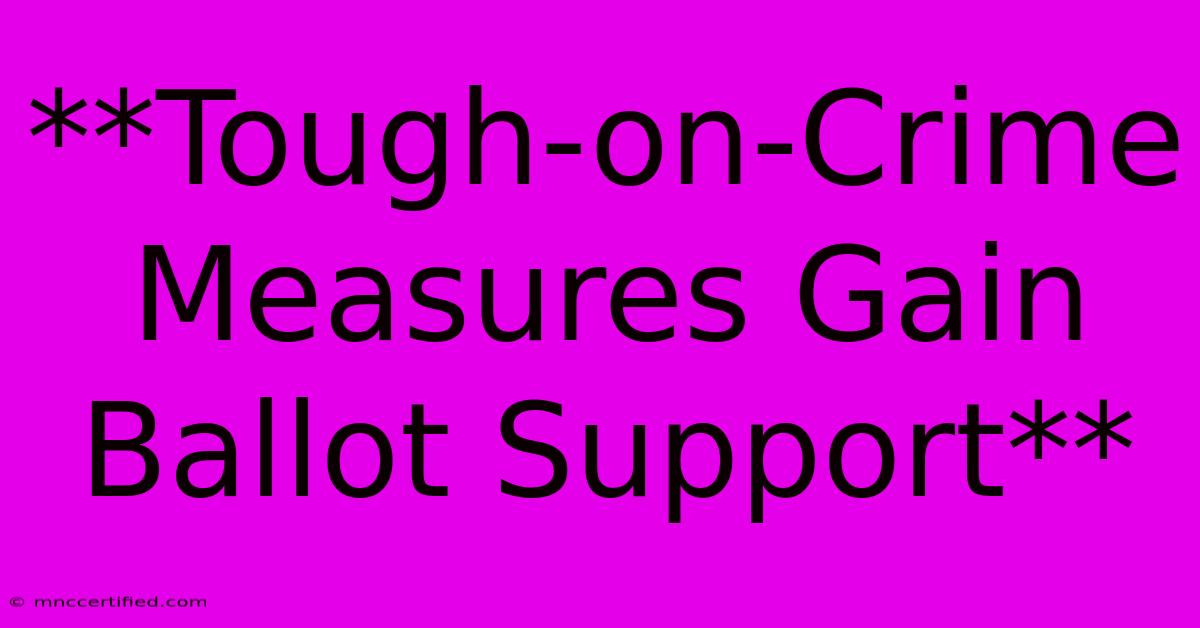**Tough-on-Crime Measures Gain Ballot Support**

Table of Contents
Tough-on-Crime Measures Gain Ballot Support: A Shifting Tide in Criminal Justice?
The United States is witnessing a resurgence of "tough-on-crime" policies, with voters increasingly backing measures that emphasize harsher punishments and stricter law enforcement. This shift, evident in recent ballot initiatives and public opinion polls, raises crucial questions about the future of criminal justice reform and its impact on communities.
The Rise of Tough-on-Crime Sentiment
Across the nation, voters are endorsing policies aimed at increasing prison sentences, reducing parole eligibility, and expanding police powers. This trend, fueled by concerns about rising crime rates and public safety, has gained traction in both urban and rural areas, cutting across traditional political divides.
Key Drivers:
- Perceived Rise in Crime: Public perception of crime rates, even when statistically inaccurate, plays a significant role in shaping public opinion.
- Media Coverage: Sensationalized news coverage of violent crimes can amplify public fear and demand for tougher law enforcement.
- Political Polarization: The "tough-on-crime" rhetoric has become deeply ingrained in political discourse, with both Democrats and Republicans vying for the "law and order" mantle.
Ballot Initiatives Reflecting Public Sentiment
Recent ballot initiatives across the country provide concrete examples of this trend:
- California's Proposition 20: This initiative, passed in 2020, reversed some criminal justice reforms, reinstating stricter sentencing guidelines and reducing parole eligibility for certain offenses.
- Florida's Amendment 4: While initially aimed at restoring voting rights for felons, this amendment was later amended to require payment of all fines and fees before voting rights could be restored, effectively disenfranchising many.
These initiatives demonstrate the growing public support for harsher penalties and tougher law enforcement measures, even when such measures are not necessarily supported by evidence-based research.
Concerns and Potential Consequences
While tough-on-crime measures may resonate with public anxieties, experts warn of their potential consequences:
- Mass Incarceration: Increased incarceration rates can lead to overcrowded prisons, strained budgets, and a cycle of recidivism.
- Disproportionate Impact: These policies often disproportionately affect marginalized communities, exacerbating existing racial and socioeconomic disparities in the criminal justice system.
- Erosion of Trust in Law Enforcement: A "law and order" approach can erode trust in police, hindering community policing efforts and increasing tensions between law enforcement and minority communities.
Moving Forward: A Balanced Approach
Navigating this complex issue requires a nuanced and balanced approach that prioritizes both public safety and justice.
Key Considerations:
- Evidence-Based Policies: Criminal justice policies should be informed by research and data, rather than fear or political expediency.
- Community Engagement: Engaging with communities most impacted by crime and incarceration is crucial to developing effective and equitable solutions.
- Investing in Rehabilitation: Focusing on programs that address the root causes of crime and provide pathways for rehabilitation is essential to reducing recidivism and building safer communities.
The rising tide of tough-on-crime measures presents a critical juncture in the ongoing conversation about criminal justice reform. By carefully weighing the potential benefits and consequences of these policies, society can strive towards a more equitable and effective system that prioritizes both public safety and individual rehabilitation.

Thank you for visiting our website wich cover about **Tough-on-Crime Measures Gain Ballot Support**. We hope the information provided has been useful to you. Feel free to contact us if you have any questions or need further assistance. See you next time and dont miss to bookmark.
Featured Posts
-
Fc Barcelona Dominates Estrella Roja 2 5
Nov 07, 2024
-
Millwall Boss Praises Leeds United X Factor
Nov 07, 2024
-
Vances Rise From Critic To Vp
Nov 07, 2024
-
Gop Wins Us Senate Majority In 2022
Nov 07, 2024
-
Aerodrome Finance Crypto Price Prediction
Nov 07, 2024